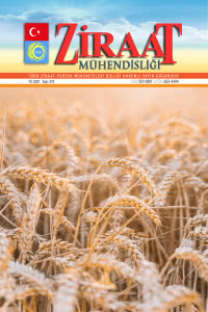Kanonik Korelasyon Katsayılarının İstatistiksel Önemliliğini Test Etmek için Hangi Test Daha Güvenilirdir?
Wilks’ Λ, Hotelling-Lawley Trace, Pillai’s Trace, I. tip hata oranı, Monte Carlo simülasyonu
Which Test is More Reliable for The Testing Statistical Significance of Canonical Correlation Coefficients?
Wilks’ Λ, Hotelling-Lawley Trace, Pillai’s Trace, type I error rate, Monte Carlo simulation,
___
- Anderson, T. W. (1984). An Introduction to Multivariate Statistical Analysis (2nd edition). John Wiley and Sons,
- Anderson, T. W. (1999). Asymptotic theory for canonical correlation analysis. Journal of Multivariate Analysis, 70(1), 1-29.
- Andrew, G. Arora, R, Bilmes, J. & Livescu, K. (2013). Deep canonical correlation analysis. In International conference on machine learning (pp. 1247-1255).
- Baggaley, A. R. (1981). Multivariate analysis: an introduction for consumers of behavioral research.Evaluation Review, 5, 123-131.
- Bradley, J. V. (1978). Robustness?. British Journal of Mathematical and Statistical Psychology, 31(2), 144-152.
- Carroll, J. D. (1968). Generalization of canonical correlation analysis to three or more sets of variables. Proceedings of the 76th Annual Convention of the Psychological Association, 3, 227–228.
- Gauch, H. G. & Wentworth, T. R. (1976). Canonical correlation analysis as an ordination technique. Vegetatio, 33(1), 17-22.
- Hotelling, H. (1936). Relations between two sets of variates. Biometrika, 28(3/4):321–377, 1936.
- Ferreira, M. A. & Purcell, S. M. (2009). A multivariate test of association. Bioinformatics, 25(1), 132-133.
- Fleishman, A. I. (1978). A method for simulating non-normal distributions. Psychometrika, 43, 521-532.
- Hotelling, H. (1951) “A generalized T-test and measure of multivariate dispersion,” in Proceedings of the Second Berkely Symposium on Mathematics and Statistics, pp. 23–41, Berkeley, CA, USA, August 1951.
- Knapp, T. R. (1978). Canonical correlation analysis: A general parametric significance-testing system. Psychological Bulletin, 85(2), 410.
- Kerlinger, F. N. & Pedhazur, E. J., (1973). Multiple regression in behavioral research. New York, NY:Holt Rinehart & Winston.
- Lawley D. N. (1938), A generalization of Fisher’s z test, Biometrika, vol. 30, no. 1‐2, pp. 180–187, 1938.
- Meloun, M. & Militky, J. (2011). Statistical data analysis: A practical guide. Woodhead Publishing, Limited.
- Pillai, K. C. S. (1955). Some new test criteria in multivariate analysis. The Annals of Mathematical Statistics, 26(1), 117-121.
- R Core Team. (2019). R: A language and environment for statistical computing. Ankara, Turkey: R Foundation for Statistical Computing. URL http://www.R-project.org/
- Rao, C. R. (1973). Linear Statistical Inference and Its Applications. 2nd ed. New York: John Wiley & Sons.
- Sharma, S. (1996). Applied Multivariate Techniques: Canonical Corelation, 391-418. John Willey and Sons Inc., USA.
- Stewart, D. & Love, W. (1968). A general canonical correlation index. Psychological bulletin, 70(3p1), 160.
- Tang, C. S. & Ferreira, M. A. (2012). A gene-based test of association using canonical correlation analysis. Bioinformatics, 28(6), 845-850.
- Takane, Y. Yanai, H. & Hwang, H. (2006). An improved method for generalized constrained canonical correlation analysis. Computational statistics & data analysis, 50(1), 221-241.
- Thompson, B. (1984). Canonical correlation analysis uses and interpretations. Newbury Park, CA: Sage.
- Vale, D. C. & Maurelli, V. A. (1983). Simulating multivariate nonnormal distributions. Psychometrika, 48, 465-471.
- Van De Velden, M. & Bijmolt, T. H. (2006). Generalized canonical correlation analysis of matrices with missing rows: a simulation study. Psychometrika, 71(2), 323-331.
- Waller, N. G. (2016). Fungible correlation matrices: A method for generating nonsingular, singular, and improper correlation matrices for Monte Carlo research. Multivariate behavioral research, 51(4), 554-568.
- Wilks S. S. (1932). Certain generalizations made in the analysis of variance, Biometrica, vol. 24, no. 3-4, pp. 471–494, 1932.
- Yanai, H. & Takane, Y. (1992). Canonical correlation analysis with linear constraints. Linear algebra and its applications, 176, 75-89.
- ISSN: 1301-0891
- Yayın Aralığı: Yılda 3 Sayı
- Başlangıç: 1966
- Yayıncı: Mehmet Ali ÜNAL
Döner Tamburlu Makina ile Hasat Edilen Fiğ + Tritikale Karışımı Haylaj Üretiminin Enerji Bilançosu
M. Emin Bilgili, Yasemin VURARAK, Ahmet İNCE
‘Köhnü’ (Vitis vinifera L.) Üzüm Çeşidinin Fenolojik, Ampelografik ve Kalite Özellikleri
Hasan KOÇ, Erdoğan ÇÖÇEN, Remzi KOKARGÜL, Yüksel SARITEPE, HAYRİ SAĞLAM
Seydi AYDOĞAN, mehmet ŞAHİN, Aysun GÖÇMEN AKÇACIK, Sümeyra HAMZAOĞLU, Berat DEMİR, İbrahim KARA
Mehmet TEZEL, Erdal GÖNÜLAL, Ramazan Çağatay ARICI, Gazi ÖZCAN
‘Köhnü’ (Vitis vinifera L.) Üzüm Çeşidinin, Fenolojik, Ampelografik ve Kalite Özellikleri
Hasan KOÇ, Erdoğan ÇÖÇEN, Remzi KOKARGÜL, Yüksel SARITEPE, Hayri SAĞLAM
Döner Tamburlu Makina ile Hasat Edilen Fiğ + Tritikale Karışımı Haylaj Üretiminde Enerji Bilançosu
